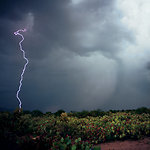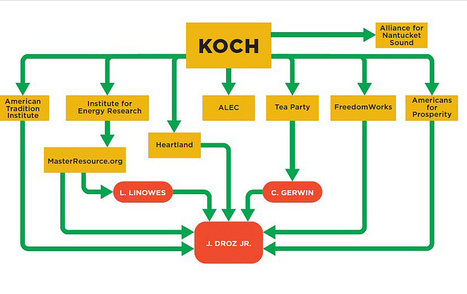 Your new post is loading...
 Your new post is loading...

|
Scooped by
Eric Byler
|
by Nate Silver From the inside, the National Centers for Environmental Prediction looked like a cross between a submarine command center and a Goldman Sachs trading floor. Twenty minutes outside Washington, it consisted mainly of sleek workstations manned by meteorologists working an armada of flat-screen monitors with maps of every conceivable type of weather data for every corner of the country. The center is part of the National Weather Service, which Ulysses S. Grant created under the War Department. Even now, it remains true to those roots. Many of its meteorologists have a background in the armed services, and virtually all speak with the precision of former officers.
They also seem to possess a high-frequency-trader’s skill for managing risk. Expert meteorologists are forced to arbitrage a torrent of information to make their predictions as accurate as possible. After receiving weather forecasts generated by supercomputers, they interpret and parse them by, among other things, comparing them with various conflicting models or what their colleagues are seeing in the field or what they already know about certain weather patterns — or, often, all of the above. From station to station, I watched as meteorologists sifted through numbers and called other forecasters to compare notes, while trading instant messages about matters like whether the chance of rain in Tucson should be 10 or 20 percent. As the information continued to flow in, I watched them draw on their maps with light pens, painstakingly adjusting the contours of temperature gradients produced by the computers — 15 miles westward over the Mississippi Delta or 30 miles northward into Lake Erie — in order to bring them one step closer to accuracy. These meteorologists are dealing with a small fraction of the 2.5 quintillion bytes of information that, I.B.M. estimates, we generate each day. That’s the equivalent of the entire printed collection of the Library of Congress about three times per second. Google now accesses more than 20 billion Web pages a day; the processing speed of an iPad rivals that of last generation’s most powerful supercomputers. All that information ought to help us plan our lives and profitably predict the world’s course. In 2008, Chris Anderson, the editor of Wired magazine, wrote optimistically of the era of Big Data. So voluminous were our databases and so powerful were our computers, he claimed, that there was no longer much need for theory, or even the scientific method. At the time, it was hard to disagree. But if prediction is the truest way to put our information to the test, we have not scored well. In November 2007, economists in the Survey of Professional Forecasters — examining some 45,000 economic-data series — foresaw less than a 1-in-500 chance of an economic meltdown as severe as the one that would begin one month later. Attempts to predict earthquakes have continued to envisage disasters that never happened and failed to prepare us for those, like the 2011 disaster in Japan, that did. The one area in which our predictions are making extraordinary progress, however, is perhaps the most unlikely field. Jim Hoke, a director with 32 years experience at the National Weather Service, has heard all the jokes about weather forecasting, like Larry David’s jab on “Curb Your Enthusiasm” that weathermen merely forecast rain to keep everyone else off the golf course. And to be sure, these slick-haired and/or short-skirted local weather forecasters are sometimes wrong. A study of TV meteorologists in Kansas City found that when they said there was a 100 percent chance of rain, it failed to rain at all one-third of the time. http://www.nytimes.com/2012/09/09/magazine/the-weatherman-is-not-a-moron.html?_r=2
by Bill McKibben If the pictures of those towering wildfires in Colorado haven't convinced you, or the size of your AC bill this summer, here are some hard numbers about climate change: June broke or tied 3,215 high-temperature records across the United States. That followed the warmest May on record for the Northern Hemisphere – the 327th consecutive month in which the temperature of the entire globe exceeded the 20th-century average, the odds of which occurring by simple chance were 3.7 x 10-99, a number considerably larger than the number of stars in the universe. Meteorologists reported that this spring was the warmest ever recorded for our nation – in fact, it crushed the old record by so much that it represented the "largest temperature departure from average of any season on record." The same week, Saudi authorities reported that it had rained in Mecca despite a temperature of 109 degrees, the hottest downpour in the planet's history. Not that our leaders seemed to notice. Last month the world's nations, meeting in Rio for the 20th-anniversary reprise of a massive 1992 environmental summit, accomplished nothing. Unlike George H.W. Bush, who flew in for the first conclave, Barack Obama didn't even attend. It was "a ghost of the glad, confident meeting 20 years ago," the British journalist George Monbiot wrote; no one paid it much attention, footsteps echoing through the halls "once thronged by multitudes." Since I wrote one of the first books for a general audience about global warming way back in 1989, and since I've spent the intervening decades working ineffectively to slow that warming, I can say with some confidence that we're losing the fight, badly and quickly – losing it because, most of all, we remain in denial about the peril that human civilization is in. When we think about global warming at all, the arguments tend to be ideological, theological and economic. But to grasp the seriousness of our predicament, you just need to do a little math. For the past year, an easy and powerful bit of arithmetical analysis first published by financial analysts in the U.K. has been making the rounds of environmental conferences and journals, but it hasn't yet broken through to the larger public. This analysis upends most of the conventional political thinking about climate change. And it allows us to understand our precarious – our almost-but-not-quite-finally hopeless – position with three simple numbers.
by LOWELL FELD, Scaling Green
A new report by the Sierra Club follows the money trail behind the “attack on renewable energy.” A few of the key points are as follows:
The tremendous growth in clean energy in recent years has made it a threat, and therefore a target, from “oil, coal, and gas interests.” Those interests have launched a coordinated, well-funded, multi-pronged assault at the federal level (e.g., Congressional attacks on the Production Tax Credit, and also harping on the Solyndra non-”scandal”), and also in the states, by groups like the dirty-energy-funded American Legislative Exchange Council (ALEC), which “provide[s] state lawmakers with ‘model legislation’ that will carry out the goals of its corporate members.” Many of the “self-appointed experts” and anti-clean-energy groups “masquerade as think tanks,” maintaining a veneer of impartiality while being funded by oil and gas interests, people like the Koch brothers, etc. (see the graphic above for a schematic of how the money flows). Key “think tanks” involved in the dirty-energy-funded assault on clean energy include the Heartland Institute, Americans for Prosperity, the American Tradition Institute, and many others. In addition, “John Droz Jr. of the American Tradition Institute, Lisa Linowes of the Industrial Wind Action Group, and Robert Bryce of the Manhattan Institute form an eclectic snapshot of the anti-renewable Merchants of Doubt.” “The oil and gas message is now focused on touting the benefits of fossil fuels — including a veritable fountain of cheap natural gas from hydrofracking — while constantly pushing out tired and inaccurate lines about clean energy being too expensive, unworkable because of intermittency, and the like.” The bottom line is that, while clean energy “is truly under siege,” it continues to maintain high approval ratings among the American people. It also ”retains its inherent advantage as the best set of solutions to help us face a warming world and its attendant challenges.” [MORE]

|
Suggested by
Joan Swift
|
The Apache Alaska Corporation is preparing to launch a deafening airgun assault as it explores for oil and gas in Cook Inlet, Alaska—home to a struggling population of 284 endangered beluga whales. At close range, the intense noise from airguns can cause injury, hearing loss and even death. Tell the Obama Administration to withdraw its approval for this devastating onslaught before it pushes the last Cook Inlet belugas one tragic step closer to extinction.

|
Suggested by
Joan Swift
|
I just signed a petition to U.S. Navy EIS Comments: Stop the killing of 1,800 whales and dolphins and the deafening of 15,900 more by ceasing the operation of the Navy's underwater sound system in the Hawaiian Islands, the California and Atlantic. Please join me. —Joan From the petition:
The Navy is required to include comments on their Environmental Impact Statement (EIS) re: the use of high frequency underwater sound for testing in Hawaii, the California and Atlantic Coasts, and the Gulf of Mexico. According to their estimates it will deafen more than 15,900 whales and dolphins and kill 1,800 more over the next 5 years. Whales and dolphins depend on sound to navigate and live. Your signature and comment will have to be included in the EIS and could stop this Naval program, potentially saving the lives of these ocean creatures. The comments must be in by July 10, 2012. To sign: http://signon.org/sign/navy-under-water-sound?source=mo&id=45292-21285856-7liFZhx

|
Suggested by
Joan Swift
|
Maryland Becomes First State to Ban Arsenic in Chicken Feed! In May 2012, Food & Water Watch helped pass legislation in the state of Maryland banning arsenic in chicken feed, making it the first state in the nation to implement such a ban. For over two years we worked with committed activists, community members and legislators to make sure this poisonous and unnecessary feed additive was banned in chicken production in the state. If you care about safe, clean, affordable food and water, read more below about our many successes.
CAIN BURDEAU, Associated Press, JAY REEVES, Associated Press, Beaumont Enterprise LAFITTE, La. (AP) — Gloom infects the hard-working shrimp and crab docks of this gritty fishing town as the second full year of fishing since BP's catastrophic oil spill kicks into high gear.
Usually folks are upbeat and busy in May, when shrimpers get back to work in Louisiana's rich waters. This spring, though, catches are down, docks are idle and anxiety is growing that the ill effects of the massive BP oil spill may be far from over.
Read more: http://www.beaumontenterprise.com/news/article/Gulf-fishermen-reel-from-seafood-troubles-3581733.php#ixzz1vxnX5aWc
MICHAEL RUBINKAM (AP) , Huff Post Green
CENTRALIA, Pa. (AP) — Fifty years ago on Sunday, a fire at the town dump ignited an exposed coal seam, setting off a chain of events that eventually led to the demolition of nearly every building in Centralia — a whole community of 1,400 simply gone. All these decades later, the Centralia fire still burns. It also maintains its grip on the popular imagination, drawing visitors from around the world who come to gawk at twisted, buckled Route 61, at the sulfurous steam rising intermittently from ground that's warm to the touch, at the empty, lonely streets where nature has reclaimed what coal-industry money once built.
Jack rabbits living in the Greater Yellowstone Ecosystem have apparently hopped into oblivion. The study speculates that the disappearance of jack rabbits may be having region-wide impacts on a variety of other prey species and their predators.
ScienceDaily A survey on the loss in the Northern Hemisphere of large predators, particularly wolves, concludes that current populations of moose, deer, and other large herbivores far exceed their historic levels and are contributing to disrupted ecosystems. The research, published recently by scientists from Oregon State University, examined 42 studies done over the past 50 years. It found that the loss of major predators in forest ecosystems has allowed game animal populations to greatly increase, crippling the growth of young trees and reducing biodiversity. This also contributes to deforestation and results in less carbon sequestration, a potential concern with climate change.
The Government has rejected shale gas technology as a solution to Britain's energy crisis, conceding it will do little to cut bills or keep the lights on.
About medical care in our country
|

|
Scooped by
Eric Byler
|
At a time of looming budget cuts, advocates of government financing of technology research argue that it is an investment in the nation’s future.
by STEVE LOHR, New York Times
LUIS VON AHN, a computer scientist at Carnegie Mellon University, sold one Internet start-up to Google in 2009, and is now on to another. With the new company, Duolingo, he hopes to tap the millions of people learning languages online to create a crowdsourced engine of translation. “We want to translate the whole Web into every major language,” Mr. von Ahn says. Enlarge This Image. Ambitious, sure, but Duolingo recently attracted $15 million of venture capital. The investors are betting on Mr. von Ahn, his idea and his growing team of 18 engineers, language experts and Web designers. Mr. von Ahn, 33, personifies some of the essential ingredients of America’s innovation culture, when it works well. An immigrant from Guatemala, he has intelligence and entrepreneurial energy to spare. And he has received a helping hand from the federal government. Duolingo began as a university research project financed by theNational Science Foundation. That pattern has been repeated countless times over the years. Government support plays a vital role in incubating new ideas that are harvested by the private sector, sometimes many years later, creating companies and jobs. A report published this year by the National Research Council, a government advisory group, looked at eight computing technologies, including digital communications, databases, computer architectures and artificial intelligence, tracing government-financed research to commercialization. It calculated the portion of revenue at 30 well-known corporations that could be traced back to the seed research backed by government agencies. The total was nearly $500 billion a year. “If you take any major information technology company today, from Google to Intel to Qualcomm to Apple to Microsoft and beyond, you can trace the core technologies to the rich synergy between federally funded universities and industry research and development,” says Peter Lee, a corporate vice president of Microsoft Research. Dr. Lee headed the National Research Council committee that produced the report, titled “Continuing Innovation in Information Technology.”
MORE: http://ow.ly/ehmA9 ;
by MICHAEL STAFFORD, The Cagle Post | Opinion
As Americans go to the polls in a few months to select our next president, one issue -- the economy -- will be foremost in voters' minds. Environmental concerns are taking a back seat this election cycle.
That's a shame. One hundred years from now, historians will be writing about what we did, or didn't do, to combat climate change and secure the environment, not about the federal deficit or the latest employment numbers.
The reason for this is simple -- we've run out of time to take action to reduce the carbon emissions driving climate change across our planet. As author Alan Weisman has observed, "by tapping the Carboniferous Formation and spewing it up into the sky, (humanity has) become a volcano that hasn't stopped erupting since t he 1700s." We have, quite literally, changed the very composition of the atmosphere.
Today, these changes are accelerating in ominous ways. At the same time, we have gained new awareness of the potential consequences for humanity -- which range from bad, to worse, to completely catastrophic.
Of the two major political parties in the United States, one- the GOP-- lives in a state of climate denial. In this topsy-turvy world, the broad scientific consensus on climate change is a hoax, denialist researchers more adept at publishing newspaper opinion pieces than peer-review journal articles are considered experts, and the claims of think-tanks funded by the coal and oil industries count for more than the views of NOAA and the National Academy of Sciences. Meanwhile, over the past two years, Congressional Republicans have been gripped by an unprecedented ecocidal fervor, launching repeated attacks on the EPA (including on its attempts to regulate greenhouse gas emissions) as well as attempts to roll back a litany of environmental protections.
The national GOP has essentially erased any mention of climate change from the party platform; local Republican legislators in places like North Carolina have tried banishing it by legislative fiat instead.
Today, the energy industry is pouring political contributions into conservative PACs and Republican coffers. This is in addition to the huge sums they already spend in their ongoing disinformation campaign designed to confuse Americans about the science of climate change. Muddying the waters, and the minds, has never been so expensive.
Throughout the Republican primary, Mitt Romney took great pains to parrot conventional "movement conservative" (read "energy industry approved") views on environmental policy and climate change. He's stated that he "would get the EPA out of its effort to manage carbon dioxide emissions from automobiles and trucks," and opposes heightened fuel efficiency standards set to take effect in 2025. His energy plan adopts a "drill, Baby, drill" approach sure to please oil, gas, and coal industry executives.
During his acceptance speech at the Republican convention in Tampa, he dismissively quipped: "President Obama promised to begin to slow the rise of the oceans and heal the planet. My promise is to help you and your family."
Romney's comments reflect a false dichotomy between prosperity and protecting the environment -- a meme often advanced by the GOP. In reality, securing our ecological future is critical for the long-term health of our nation. [MORE]

|
Suggested by
Joan Swift
|
Not if we stop them! As we reported a few weeks ago, these amendments represent a sneaky, behind-closed-doors attempt to make GMO foods immune from court review. Now we have learned of an even sneakier, even more questionable legislative maneuver that might get them passed. The usual procedure for passing bills in Congress is for the House to pass its version and the Senate to pass its version. The two bills are reconciled by a joint conference committee, and then both chambers pass the final bill. The Senate has already passed its version of the Farm Bill, the comprehensive omnibus bill that is the primary agricultural and food policy tool of the federal government for the next four or five years. The House version, which includes the sneaky pro-GMO amendments, has run into trouble. We have learned that the House Rules Committee has scheduled a hearing today (Tuesday, July 31) on a one-year extension of the 2008 Farm Bill—a Continuing Resolution, or CR. If passed in the House (it will very likely fail in the Senate), this will trigger a conference committee. MORE: http://ow.ly/d3vPP

|
Suggested by
Joan Swift
|
The US is facing one of the worst droughts in our history, but Agriculture Secretary Tom Vilsack says he doesn't want to "opine" as to the role of climate change.* That is not acceptable. The scientific links between climate change and drought are well established by his own Department, and it's Secretary Vilsack's responsibility to share that information with farmers and the American public. Sign this petition to tell Secretary Vilsack to help America's farmers by giving them the truth about manmade climate change: http://act.engagementlab.org/sign/climate_vilsack_FDN/

|
Suggested by
Joan Swift
|
This rogue agency secretly captured thousands of emails that its disgruntled scientists sent to Congress, labor officials, journalists and even the president. The New York Times is reporting that the US Food and Drug Administration conducted a wide-ranging surveillance operation against a group of its own scientists in an attempt to halt criticism of its medical review process. The agency also had an “enemies list” of sorts that included agency employees, congressional officials, outside medical researchers, and journalists thought to be working together to disseminate negative and “defamatory” information about the FDA. The FDA used spy software that was installed on the workers’ laptops that took screen captures, tracked keystrokes, intercepted personal emails, and even copied documents that were on their personal flash drives. The surveillance, according to the Times, sprang out of a bitter dispute between the scientists and their FDA supervisors over the scientists’ claims that faulty review procedures at the agency led to the approval of some medical devices that had exposed patients to dangerous levels of radiation. http://www.anh-usa.org/fda-spied-on-its-own-scientists-as-part-of-a-massive-witch-hunt/

|
Suggested by
Joan Swift
|
CLICK HERE: http://bit.ly/LVtE5J This week the House of Representatives will consider a provision to House Agricultural Appropriations Bill that will fundamentally undermine the concept of judicial review. Hidden under the guise of a “Farmer Assurance Provision” (Section 733), the provision strips the rights of federal courts to halt the sale and planting of genetically engineered crops during the legal appeals process. In the past, legal advocates have successfully won in court the right to halt the sale and planting of unapproved GMO crops while the approval of those crops is under review by a federal judge. This dangerous new House provision, which we're calling the Monsanto Protection Act, would strip judges of their constitutional mandate to protect consumer rights and the environment, while opening up the floodgates for the planting of new untested genetically engineered crops, endangering farmers, consumers and the environment. Once again, Monsanto and the biotech industry are working behind closed doors to undermine your basic rights. This time they’ve gone too far! Join us in putting a stop to the Monsanto Protection Act!
CLICK HERE: http://bit.ly/LVtE5J
Salt in the diet should be avoided, right? No, not really. by GARY TAUBES, New York Times THE first time I questioned the conventional wisdom on the nature of a healthy diet, I was in my salad days, almost 40 years ago, and the subject was salt. Researchers were claiming that salt supplementation was unnecessary after strenuous exercise, and this advice was being passed on by health reporters. All I knew was that I had played high school football in suburban Maryland, sweating profusely through double sessions in the swamplike 90-degree days of August. Without salt pills, I couldn’t make it through a two-hour practice; I couldn’t walk across the parking lot afterward without cramping. While sports nutritionists have since come around to recommend that we should indeed replenish salt when we sweat it out in physical activity, the message that we should avoid salt at all other times remains strong. Salt consumption is said to raise blood pressure, cause hypertension and increase the risk of premature death. This is why the Department of Agriculture’s dietary guidelines still consider salt Public Enemy No. 1, coming before fats, sugars and alcohol. It’s why the director of the Centers for Disease Control and Prevention has suggested that reducing salt consumption is as critical to long-term health as quitting cigarettes. And yet, this eat-less-salt argument has been surprisingly controversial — and difficult to defend. Not because the food industry opposes it, but because the actual evidence to support it has always been so weak.
DAVID VOGNAR, Huff Post Green
The U.S. Environmental Protection Agency (EPA) held hearings in Chicago's Ralph H. Metcalfe Federal Building on Thursday in which members of the public were invited to express their opinions about (but more often than not, expressed their adulation over) the proposed carbon pollution standards for new power plants. With moments of compelling commentary, the forum provided a pressing reminder that there are real victims of our choice to pollute or put up with pollution, and in many instances those victims are from low-income areas. Some of the comments dealt with the nuts and bolts of the regulation. The EPA would restrict emissions to 1,000 pounds of carbon dioxide per megawatt hour, compared to the average 1,800 pounds per megawatt hour that power plants emit. One woman opposed to the proposed carbon pollution standards for new power plants cited a Fox News report and highlighted the potential for the regulation to impact electricity bills. (Plenty of economists would disagree with her.) Seated next to her at the front of the room waiting to speak was Lawrence Lemon, a man from Columbus, Ohio, whose poignant story of how air pollution impacted his family would make the woman's claims sound insouciant.
By Wyatt Olson, Stars and Stripes YOKOTA AIR BASE, Japan — As the Fukushima Daiichi nuclear plant crisis escalated in March 2011, Japan Prime Minister Naoto Kan secretly requested a worst-case scenario from the chairman of the Japan Atomic Energy Commission. Two weeks later, Kan received a document that projected possible dire consequences for the four reactors damaged as a result of the magnitude 9.0 earthquake and tsunami, according to a recent investigative report by the Rebuild Japan Initiative Foundation, an independent think tank founded to probe the causes of the plant disaster. Among the risks was a loss of cooling water in Unit 4, which houses most of the plant’s spent fuel that is not in secure dry casks. The fuel, if left exposed, would superheat and melt, releasing a massive amount of radiation.
Science Daily As wolf populations grow in parts of the West, most of the focus has been on their value in aiding broader ecosystem recovery -- but a new study from Oregon State University also points out that they could play an important role in helping to save other threatened species. In research published in Wildlife Society Bulletin, scientists suggest that a key factor in the Canada lynx being listed as threatened under the Endangered Species Act is the major decline of snowshoe hares. The loss of hares, the primary food of the lynx, in turn may be caused by coyote populations that have surged in the absence of wolves. Scientists call this a "trophic cascade" of impacts.
In a perfect world, we could all bring reusable food containers
and coffee mugs every time we visited a restaurant or cafe.
|

 Your new post is loading...
Your new post is loading...
 Your new post is loading...
Your new post is loading...





































